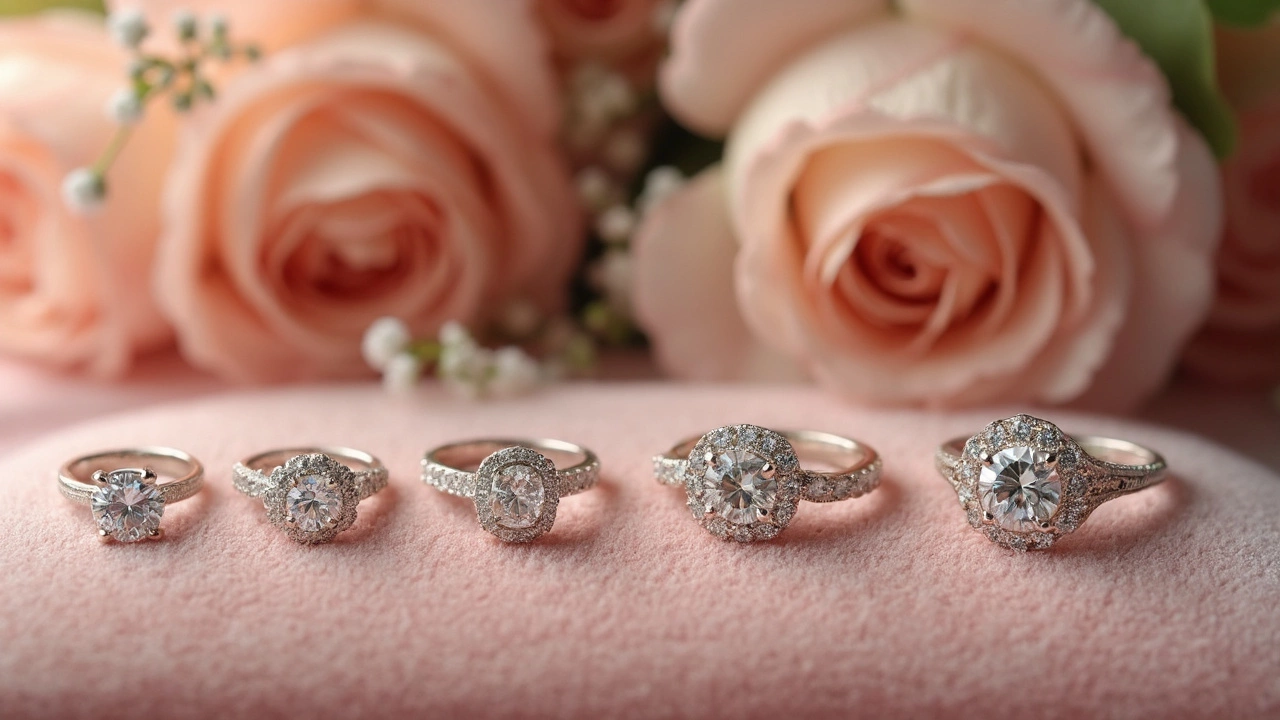Carats are probably the first thing that comes to mind when talking about diamond rings, right? But here's the kicker: a bigger carat doesn't always mean a better ring. It's more about finding the right balance for you. Carats measure the weight of the diamond, not the size, which is a common mix-up. So, if you're scratching your head over how many carats your wedding ring should be, you're definitely not alone.
Let's break it down. Think about your budget first. While it's tempting to go for the biggest rock in the store, your wallet might have other plans. Remember, the carat size hikes up the price, sometimes exponentially. But hey, less is more sometimes, especially if the ring's quality is top-notch.
Understanding Carats
Let's get into the nitty-gritty of carats. In the diamond world, carats are like the scale for measuring how heavy a diamond is. But here's where it gets interesting: two diamonds with the same carat weight can look different in terms of size. Why? It's all in the cut – more on that later.
To make it simple, one carat equals 200 milligrams. A lot of folks think this is the same as size, but size and weight aren't twins. The spread of the diamond's cut, its shape, and depth all play into how big it actually looks on your finger. Imagine a person who's tall and lean versus someone shorter and stockier – they're both unique!
The Pricing Factor
Carats are a big deal in the pricing game. As the carat count goes up, so does the price tag. It's like buying a larger pizza; there's a surcharge for all that extra cheese! This step up in price isn't just double; it often jumps exponentially. Keep in mind, all the bling isn't just about weight. Quality, as expressed in the 4Cs (cut, color, clarity, carat), is key.
Visual Impact vs. Carat
Want your diamond to pop more? Consider diamonds with slightly more spread. This way, you can snag a ring that catches the eye without the extra weight or cost. A half-carat well-cut diamond may shine brighter than you think.
| Carat Weight | Average Diameter (Round) | Price Guide |
|---|---|---|
| 0.5 carat | 5.0 mm | $1,000 - $2,000 |
| 1 carat | 6.5 mm | $4,500 - $6,000 |
| 2 carats | 8.2 mm | $12,000 - $18,000 |
This chart gives you a quick glance at how the carat relates to size and potential costs. Remember, the deeper the cut, the smaller it may appear!
Budget Considerations
Alright, let's talk about the budget side of things because, let's be real, it plays a huge part in picking out that perfect wedding ring. First off, it's important to set a budget that feels right for you. The old rule of spending two or three months' salary on a ring is pretty outdated. Today, it's all about what feels comfortable for you and your partner.
Now, when we're talking carats, remember each increase in carat size significantly ups the price. For instance, a jump from 1 to 1.5 carats may cost a lot more than adding an extra 0.5 carats to a larger stone. So, if you're trying to maximize your shine on a budget, consider slightly smaller diamonds. They'll sparkle the same under the right cut and setting.
A Little Trick: The Magic of Just Under
Here’s a trick: diamonds just below whole carats, like 0.9 instead of 1 carat, often look almost the same size to the naked eye but can be significantly cheaper. Jewelers often refer to these as "magic sizes." So, you might want to keep an eye out for them when shopping for wedding rings.
Consider the metal band as well. Platinum bands are more expensive than white gold, yet they look quite similar. Opting for a less expensive band can leave you more room in your budget for the diamond itself.
Prioritize the 4 Cs
Then there's the 4 Cs: carat, cut, color, and clarity. Sometimes, you can compromise on one or more of the other Cs to get the carat size you want without breaking the bank. For example, a near-colorless diamond can look just as stunning as a colorless one, but cost way less.

Lifestyle and Practicality
When you're choosing a wedding ring, one thing you really have to think about is how it fits into your daily life. Sure, those two-carat diamond rings look stunning, but if you're someone who's always on the go or uses your hands a lot for work, practicality beats glitz every time. Wedding rings should be about more than just showing off; they're meant to be worn daily and last a lifetime.
Let’s say you're a chef, a gardener, or maybe even a gym enthusiast. A huge rock might sound nice, but it could become a nuisance if it keeps snagging or getting in the way. Generally, rings under one carat are more comfortable for everyday activities because they don’t protrude as much, and they tend not to get caught on things as easily.
Durability Matters
Smaller rings are more durable in the long run. A ring that you wear every day faces constant exposure to things like water, soap, and even the weather. Plainer designs tend to stand up better to this wear and tear. That doesn’t mean you have to sacrifice style; just be savvy about what suits your routine.
Also, let’s consider the metal your ring is made of. Gold, for example, comes in different karats, and higher-karat gold, while more valuable, is also more prone to scratching. Platinum is a sturdier choice if you're looking for something that can handle a bit of rough handling.
Personal Comfort
Comfort is key. You’ll be wearing this ring every day, after all. Try different styles to see what feels best on your finger. Some people prefer wider bands, while others find them cumbersome. Don’t just go for a ring that looks great in the box; pick one that your finger will love too.
In short, choose a ring size that matches your lifestyle. You don't want a stunning diamond that's more of an off-on piece because it's uncomfortable or not practical enough for everyday wear.
Finding the Perfect Balance
Nailing down the right carat for your wedding rings isn't a one-size-fits-all scenario. The perfect balance is personal, reflecting your style, needs, and, yes, your pocketbook too! But how do you strike that sweet spot?
Think About Your Personal Style
Are you all about dainty and understated elegance, or do you lean towards bold and standout pieces? Your style can guide how many carats should sit on your finger. If subtlety is your thing, a lower carat might be perfect. For those who love making a statement, go bigger—but ensure the design aligns with your taste.
Consider Daily Wear and Tear
Planning to wear that beauty every day? Then think practical. A high-carat diamond, especially if it's prominently set, might snag or get in the way during daily tasks. If you're hands-on with your work or hobbies, a smaller carat size might make life much more comfortable and prevent those heart-sinking "Oh no!" moments if you accidentally ding your ring.
Visual Impact vs. Budget
Surprisingly, you can achieve impressive visual impact without overspending. This is where shape and cut come into play. The right cut can make a diamond appear larger, while strategically selecting a slightly lower carat can keep costs manageable. Engagement rings should dazzle, but not at all costs.
Set Your Priorities
Ultimately, decide what matters most—whether it's a larger stone, higher quality, or a specific design. Make a list of your top priorities before shopping, and don't shy away from communicating these to your jeweler. They can guide you toward options that strike a happy medium among carat weight, quality, and price.
| Carat Size | Typical Price Range | Popularity |
|---|---|---|
| 0.5 Carats | $1,000 - $3,000 | Moderately Popular |
| 1 Carat | $3,500 - $7,500 | Very Popular |
| 2 Carats | $8,500 - $16,000 | Luxurious and Prestigious |
Remember, your wedding ring is a symbol of your love—not a measure of carat size. Finding that perfect balance ensures the ring suits the beautiful life you're building together.
